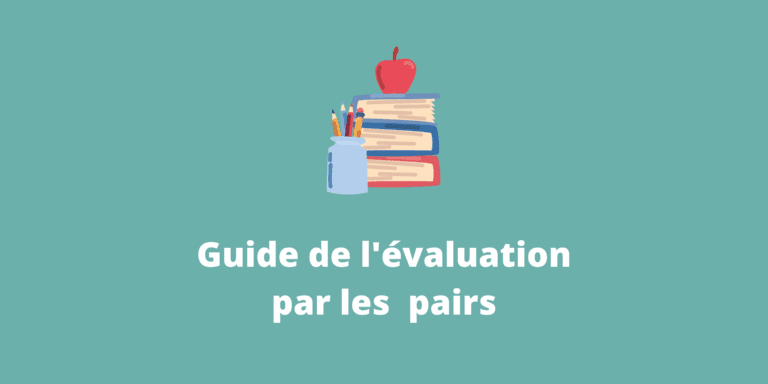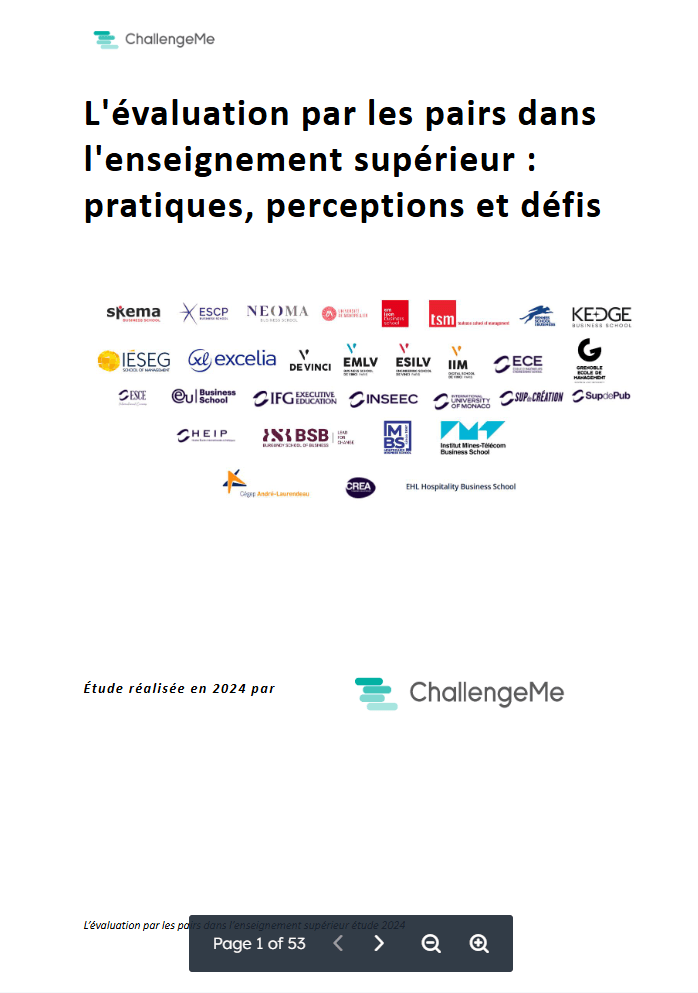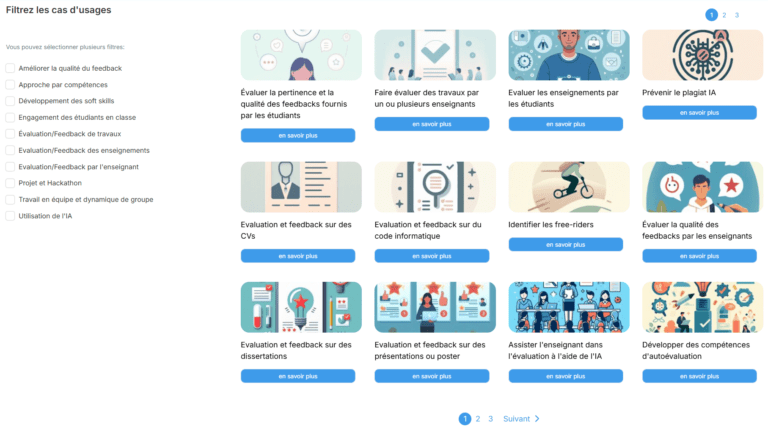Definition
For us, peer assessment is a broad term for a range of activities that include students in the act of evaluating and providing feedback on the work of their peers.
It can be formative, where students give feedback on each other's work before a final product is submitted, or summative, where students use the assessment criteria to grade other students' submissions.
Peer assessment is most often used with written work, but can also be used with presentations, performances, posters, videos and other types of work. It is also commonly used as a strategy for assessing group work and homework.
There are many benefits for students:
- receive more frequent and understandable feedback than when the instructor alone provides it
- get feedback on their drafts and be able to make improvements
- engage in the critical analysis and reflection associated with assessing their peers' work.
How does peer review work?
Peer assessment can take many forms, depending on learning objectives, disciplinary context and available technologies. Peer assessment is often characterized by a formative or summative approach.
Example of a summative peer evaluation
- Students are introduced to the assignment and evaluation criteria
- Students are trained and practiced on how to use the scoring grid and provide feedback.
- Students complete and submit a final assignment
- Students evaluate the assignments of 3 to 6 other students using the grading criteria and provide feedback.
- Grades are determined for each student by taking the average grade given by their peers.
- Instructor and students reflect on the activity with an emphasis on reinforcing the learning that occurred by giving peer feedback
Example of a formative peer assessment
- Students are introduced to the assignment and evaluation criteria
- Students are trained and practiced on how to evaluate and provide feedback
- Students complete and submit a draft
- Students evaluate each other's drafts and give feedback
- Students reflect on feedback received and revise their work for final submission
- Homework is graded by the teacher
- Instructor reflects on the activity with the class
How can peer assessment improve student learning?
Clarify assessment objectives and criteria
The act of peer assessment forces students to take a closer look at the assessment criteria and gives them practice in applying the criteria to several examples, enabling them to better reflect on how their own work matches the criteria. Students may have different conceptions of learning objectives and criteria than instructors (Hounsell, 1997; Norton, 1990). Through the practice of peer assessment, students will become familiar with assessment criteria and aware of the traits that distinguish successful performances from those that fall short of expectations.
More feedback, faster
Instructors are often unable to provide frequent detailed feedback on multiple assignments. Instructor time is cited as one of the main factors limiting increased opportunities for students to practice and get feedback on their work (Cho and Schunn 2007). In addition, students are often asked to wait a few weeks until they receive feedback from an instructor. Receiving feedback from several peers also provides potentially more diverse feedback and offers the opportunity to learn from different angles.
Learning by giving feedback
Students learn by providing constructive feedback, as it involves them in complex processes of problem-solving, diagnosing problems and suggesting solutions. Studies have shown that providing elaborate feedback including problem descriptions and scaffolded solutions is the element of peer assessment that most benefits student learning (Lie et al. 2010, 2012; Topping et al. 2013).
Greater commitment to homework
Peer assessment increases the time students spend critically reflecting on an assignment by "reviewing, summarizing clarification, giving feedback, diagnosing erroneous knowledge, identifying missing knowledge and considering deviations from the ideal". (Topping 1998) These activities help to reinforce and deepen learning.
Active engagement
Peer assessment encourages active learning by involving students in the feedback process rather than simply being passive recipients of a teacher's feedback (Liu and Carless 2006; Cartney 2010; Nicol 2011). By doing so, they are alerted to the value of feedback rather than seeing it as a justification for a grade. Peer assessment can help provide opportunities for feedback earlier so that students can use it to improve their work by revising drafts or incorporating what they've learned into later assignments. Studies show that students are more motivated to engage and use feedback when the immediate usefulness of that feedback is clear (Moore and Teather 2013).Opportunities to apply knowledge through practice and receive quality feedback on that practice are known to have positive impacts on student learning (Nicol and Macfarlane-Dick 2006).
Better understanding of their own work
Students develop the metacognitive ability to think more critically about their own work through the assessment of their peers' work. Training and experience in peer assessment can also help to correct the detrimental effects of students overestimating or underestimating their own performance and can result in students becoming more independent learners, reducing dependence on feedback from instructors (Nicol, Thomson and Breslin 2014).
Lifelong skills development
Peer assessment helps students to develop lifelong transferable skills, such as engaging in critical review of the work of their peers and colleagues, communicating feedback in a constructive and positive way, learning to accept feedback from others and incorporating feedback from others into their work. This helps prepare them to engage in such activities independently once they leave school.

Questions to ask yourself before a peer review?
The concept of peer assessment is broad and can therefore be implemented in a variety of ways. It is therefore important to reflect on some of the basic elements that go into designing a peer assessment activity in light of the desired learning outcomes. (modified from Gielen 2010 and Topping 1998).
-
Object of evaluation
What will the students produce? (article, web page, poster, presentation, video, participation/contribution to a group project) What skills do the students need to develop and demonstrate when they produce?
-
Peer review product
What results do students create when evaluating their peers? (grades, rubric, ranking, guided questions, qualitative feedback)
-
Formative or summative
Will the final product be peer-reviewed for a grade, or will students submit a draft product for peer review that they can revise before submitting it to the teacher?
-
Rating
How will students be graded on the assignment? Will peer grading replace instructor grading (substitution)? Will students receive grades or feedback from both peers and instructors (partial substitution)? Or, will peer assessment provide additional feedback but be primarily evaluated by the instructor for the final grade (supplementary)? Will you give feedback to students or award a grade, with or without evaluation, for their peer assessments?
-
Organization
How will peer reviewers be assigned? (e.g. randomized, self-selected, selected by you, small group, paired). How many assessments will you ask each student to complete? Will the assessments be anonymous, or will there be a dialogue between peers who assess each other?
-
Training
How experienced and confident are students in peer assessment? How will students be trained to assess their peers' work and provide feedback? At what point in the process does training take place?
-
Frequency and positioning
Will there be several activities developed over the course of a quarter, or just one peer-reviewed activity? Will peer evaluation be used to provide feedback at several stages of a larger assignment, or at the end of an assignment? Will there be a "peer feedback exercise activity" to familiarize students with this? Have students' skills and familiarity developed over a series of program-level courses, or is this type of activity unique to your course?
Best practices
-
Set expectations and clarify objectives
Students are often apprehensive about peer assessment, particularly when peer grading is involved, but also when it comes to giving and receiving feedback. It's important to clarify the expectations and aims of the activity for everyone involved to build confidence at the outset and get buy-in from students. Students could be invited to read one of the pedagogical research studies on peer evaluation cited in this guide.
-
Providing training for students
Particularly for novice students, it's important to offer training activities to teach students how to assess their peers' work and provide constructive feedback. This can help not only to increase students' ability to carry out peer assessments, but also to improve students' confidence in the process.
-
Evaluation and feedback model
Model the act of assessing and giving feedback to your students by guiding them through the assessment process with some sample assignments. It's helpful to provide examples of assessed work that show different levels of performance or indicate common challenges you want students to focus on. This can be done through online modules or as in-class activities.
-
Focus on written feedback
Although evaluating peer texts using rubrics and scoring criteria can improve students' writing skills in some contexts, studies show that students consistently benefit more from providing written feedback to their peers than from any other activity that is part of the peer review process (Lu et loi 2012, Wooley et al. 2008).
-
Encourage elaborate feedback
Novice reviewers tend to focus on surface feedback, concentrating on grammar or error corrections rather than substantive criteria. Giving specific instructions, training and feedback guides can help improve the quality of feedback and the resulting learning benefits. Studies show that students benefit most from building feedback where they not only identify strengths and weaknesses, but offer suggestions and strategies for improvement. (Patchan and Schun 2015)
-
Allow opportunities to apply feedback
Feedback is most useful when learners act on it. Build into the series of activities opportunities for students to make revisions to their work and reflect on how the feedback they received influenced the revisions. It can also be useful to get students thinking about the feedback and revision process. Why did they accept or reject suggestions? How did they modify their work after receiving feedback? How did the evaluation of their peers' work change the way they saw their own work?
-
Allow sufficient time and space for the process
To encourage a deeper level of engagement, begin the peer review process early in the term so that students have sufficient time to reflect on the feedback they receive and apply it to their learning. through revision or on later assignments. Studies have shown that revisions early in the process focused on substantial content-based changes, while revisions closer to the deadline resulted in finishing changes focused on grammar, word substitution and spelling (Baker 2016; Cho and MacArthur, 2010). In a short 12-week course program, the ideal design will begin peer review activities in week 3.
-
Aligning peer assessment with key learning objectives
Ensure that peer assessment activities are aligned with core learning objectives so that students are clear about how the activities benefit their learning and are not perceived as an additional task of little value. Peer assessment activities require considerable time and effort on the part of students, but their strategic positioning can help focus students' efforts and deepen their critical engagement around key learning objectives. If marks are awarded for feedback, they should be weighted sufficiently to indicate the importance of this activity.






